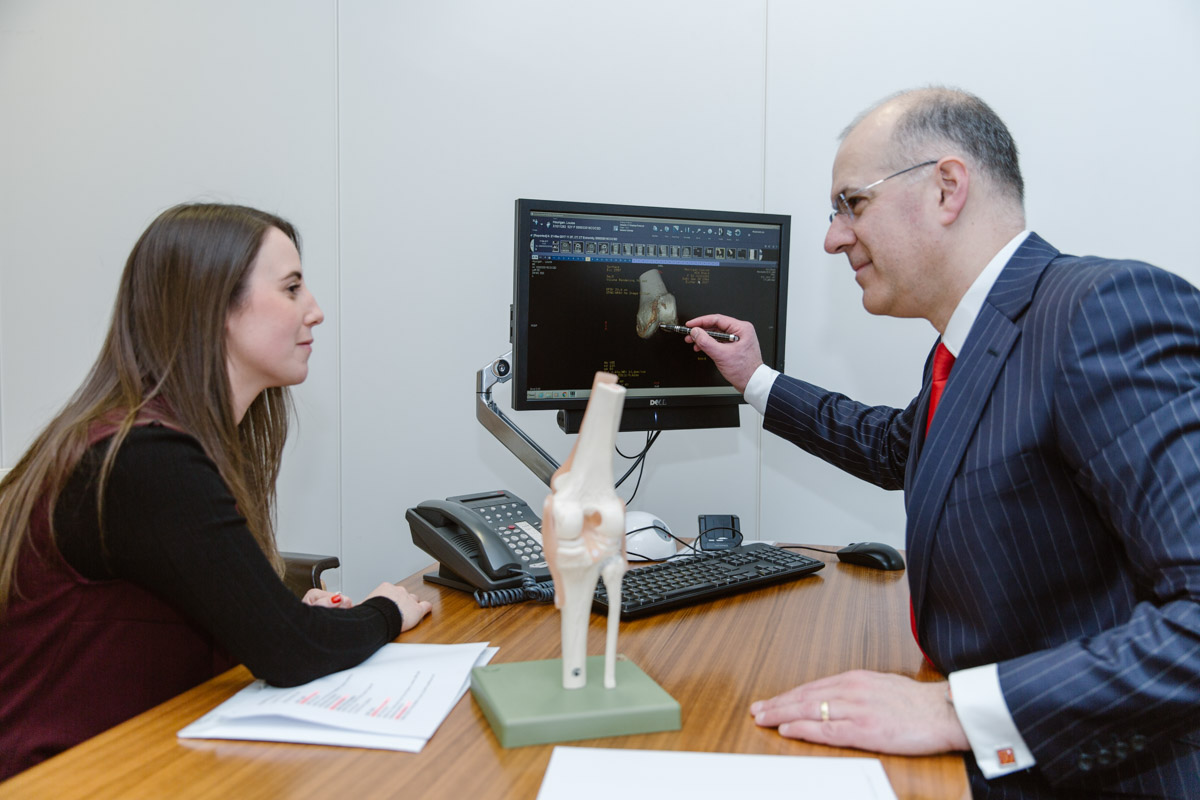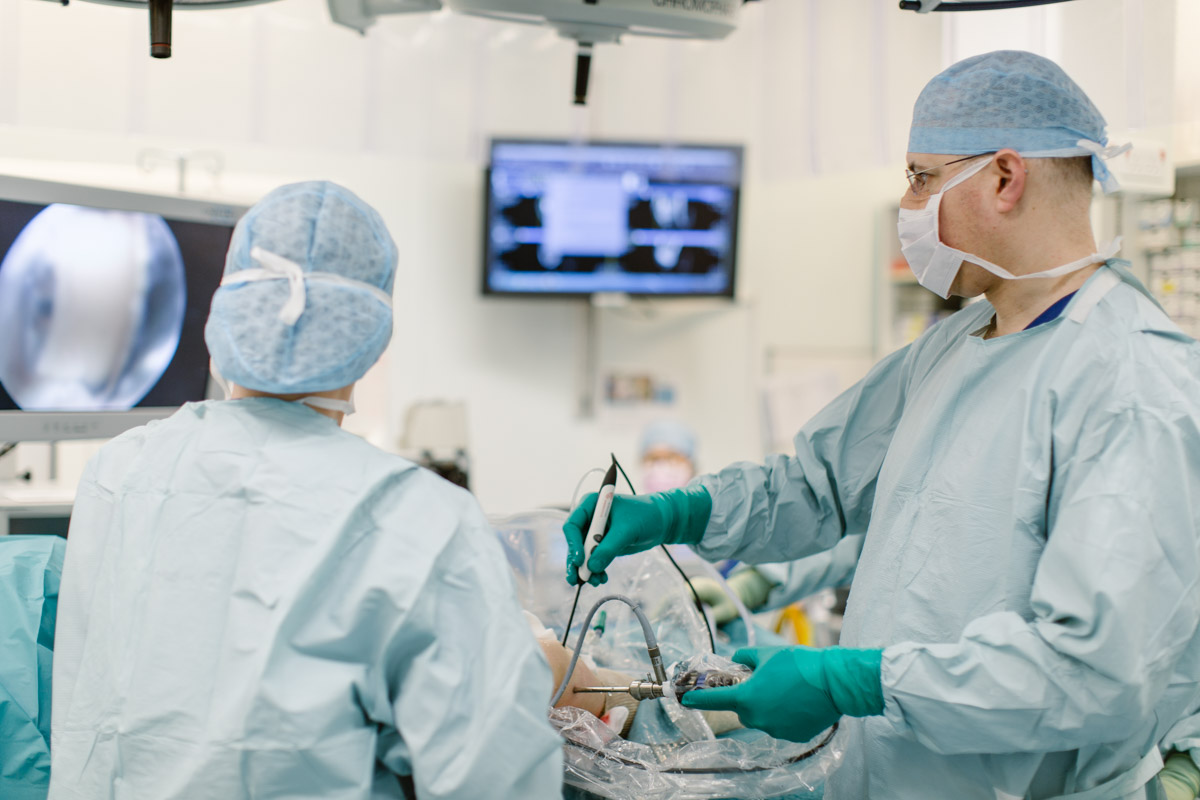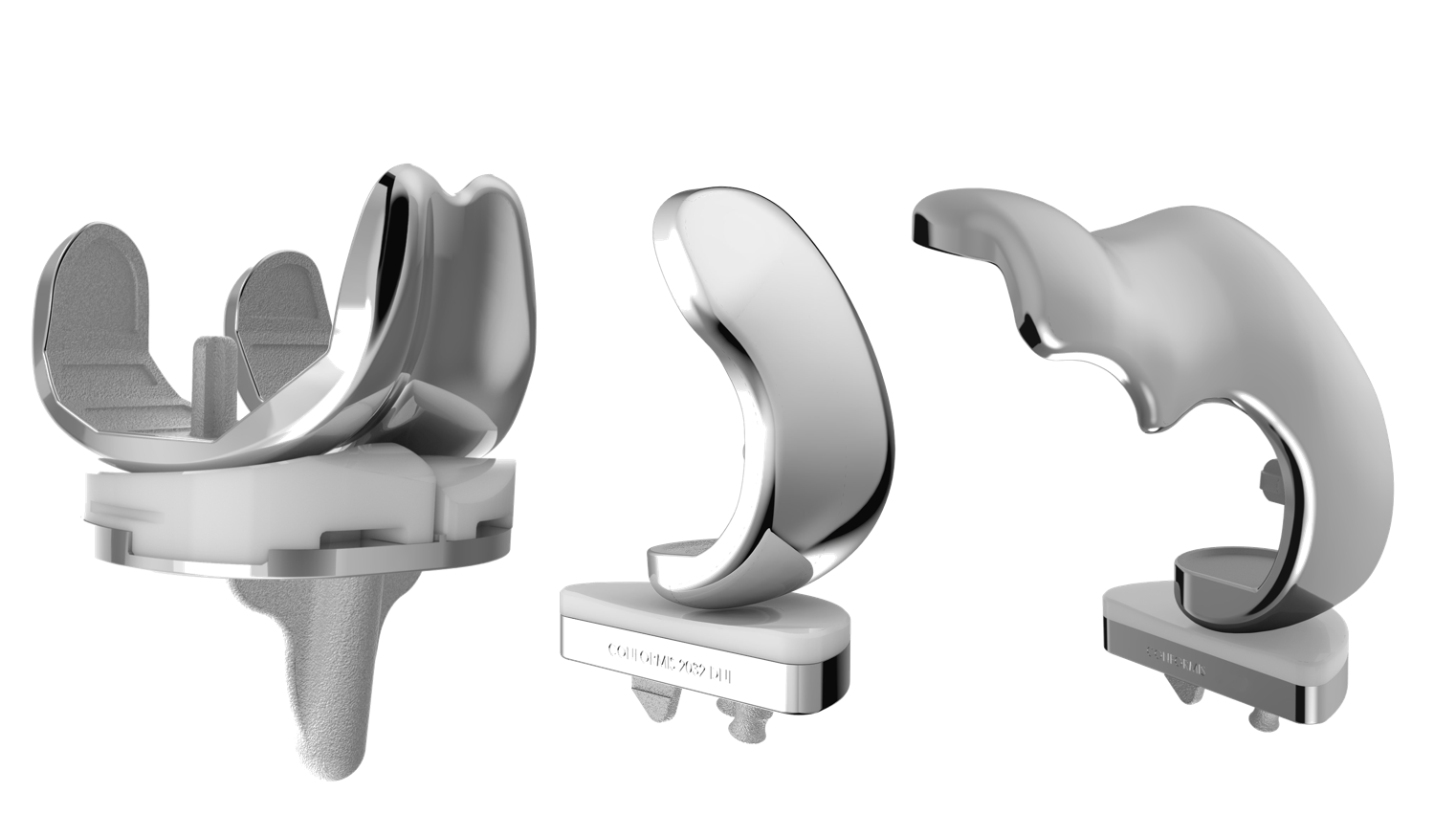This article explains the importance of a 'custom made' knee implant and why it is important to tailor knee replacement for each individual. Ian McDermott refers to patient satisfaction outcome data for patients having had surgery with custom made vs. conventional knee replacement surgery. He says, "Make sure that the timing of any surgery is appropriate and that you’re offered the best specific option for you, personally, as an individual, with the best prosthesis".
The questions that all patients considering knee replacement surgery should ask:
 1. What is a knee replacement and how is it done?
1. What is a knee replacement and how is it done?
2. Are there different types of knee prosthesis?
3. What is a ‘standard’ off-the-shelf knee replacement?
4. How do we assess the individual differences between people's knees?
5. What is a custom-made knee implant and what are its benefits?
6. Why are there big differences in patient satisfaction?
7. What about robotic surgery?
What is a knee replacement and how is it done?
Knee replacement surgery involves opening up the knee through a long incision at the front of the joint, and the surfaces of the bone (and any remaining areas of damaged cartilage) are shaved away. A metal surface is then cemented onto the end of the femur, and another metal surface is cemented onto the top of the tibia, with a hard plastic ‘washer’ placed in-between the two metal surfaces. Assuming that the patella (kneecap) needs resurfacing too, then this is also resurfaced with a plastic dome that’s cemented onto the back of the bone (the entire bone itself is not actually removed, as some people seem to think). The metal and plastic together, is what’s referred to as a ‘prosthesis’.
Are there different types of knee prosthesis?
There are several different options, when it comes to knee replacement prostheses.
Cemented vs uncemented
First, most prostheses rely on special bone cement to fix them in place. Some, however, are ‘uncemented’. There’s probably little, if any, difference between cemented vs uncemented femoral prostheses, but cemented tibial prostheses seem to do better, and all patellar buttons have to be cemented. So, the large majority of knee replacements are cemented.
Total vs partial
If the damage in your knee is only affecting just one specific area of the knee (a ‘compartment’), such as the inner side of the knee (the medial compartment), the outer side (the lateral compartment) or just the front of the knee (the patellofemoral compartment), then you might be able to get away with having just a partial knee replacement rather than a total.
nothing is more personalised than a custom-made knee replacement
Partial knee replacement is a slightly smaller operation with slightly quicker recovery times and slightly better outcomes, in terms of patient function and satisfaction. However, partial replacements tend to carry a higher potential risk of future revision surgery than a total (with normally, the partial needing to be converted to a total). So, partials tend to be more suitable for younger, more active, high-demand patients, but appropriate patient selection is critically important.
 Cruciate-retaining vs posteriorly-stabilised
Cruciate-retaining vs posteriorly-stabilised
The anterior cruciate ligament (ACL) is always removed with every total knee replacement procedure (but not with a partial). However, this doesn’t matter, because the ACL is mainly needed only for cutting and pivoting manoeuvres at speed – which isn’t something that knee replacement patients are generally capable of doing or would normally be advised to attempt.
With a cruciate-retaining prosthesis, it is the posterior cruciate ligament (PCL) that is retained, and this stops the tibia from wobbling backwards. For knees, however, where there is absence of the PCL from previous trauma, or where there is severe stiffness, bone loss or deformity, a posteriorly stabilised (PS) prosthesis is often needed. With a PS prosthesis the PCL (if it is still there) is removed, and additional stability to the joint is provided by a post on the plastic washer that engages in a ‘socket’ in the femoral prosthesis, to give better stability. The negative of a PS knee, however, is that a bit more bone has to be removed from the end of the femur to create the ‘socket’ in the femoral prosthesis.
What is a ‘standard’ off-the-shelf knee replacement?
With a ‘standard’ knee replacement the prosthesis comes in different size categories: A, B, C etc. Also, the prosthesis comes in one single standard shape: based on assumptions about the ‘average’ shaped knee.
With respect to sizing: if you’re in the middle of the ‘A’ range or the ‘B’ range, then great; however, if you’re half-way in-between then you’re going to get something that’s either a bit too big or a bit too small for your knee.
Does this matter? Yes: under-hang (from undersizing) can cause increased bleeding in the knee post-operatively and it can be associated with poorer fixation of the prosthesis. Overhang by as little as just 3mm has been shown to be associated with rubbing of the prosthesis against the adjacent soft tissues, with ongoing pain post-operatively and with poorer patient satisfaction levels.
How do we assess the individual differences between people's knees?
With respect to shape: with a standard knee replacement design, many assumptions are made about the best shape for a knee, that will best match most people. The reality, however, is that not only do people have different sized knees, but the shape of people’s knees also varies considerably, with different sizes medially vs laterally, and with different curves and contours. If you replace one shaped knee with a prosthesis that is significantly differently shaped, then the knee is unlikely to move in exactly the same way (joint kinematics), and hence the knee is less likely to feel ‘normal’ to that specific patient.
Standard knee replacement surgery can be like trying to ram a square peg into a round hole and then expecting the patient to somehow be happy!
The answer to these issues is simple: have a prosthesis that exactly matches your individual size, shape and contours, with millimetre precision: i.e. a personalised prosthesis for each individual person – and that means a custom-made knee.
What is a custom-made knee and what are its benefits?
 With a custom-made knee, we perform a high-res (fine-cut) CT scan of the knee, including views of the hip and the ankle. The CT data is sent to a company in America called Conformis, and Conformis then design and manufacture a custom-made knee replacement prosthesis specifically for that patient.
With a custom-made knee, we perform a high-res (fine-cut) CT scan of the knee, including views of the hip and the ankle. The CT data is sent to a company in America called Conformis, and Conformis then design and manufacture a custom-made knee replacement prosthesis specifically for that patient.
Just like a suit – if you want to buy a suit and walk out of the shop actually wearing it straight away, then you’re going to have to buy an off-the-peg suit. However, if you want a suit that’s made to measure, that will fit you perfectly and that will feel really good… then it’s going to need to be tailor-made. And this takes time. It normally takes Conformis about 6 weeks to design, manufacture and deliver the patient’s custom-made prosthesis back here to us in London, ready for surgical implantation.
The proof is in the pudding
The theory sounds fine… but the actual proof is in the pudding. With a standard off-the-shelf prosthesis, the patient satisfaction rates are about 80 to 85%. This is ‘reasonably’ good; however, that means that 15 to 20% of patients are left unhappy after their knee replacement surgery, and that’s a very big deal! In normal times, there were about 100,000 knee replacement procedures being done per year in the UK: that equates to about 15,000 to 20,000 unhappy patients every year! This is probably why knee replacement surgery hasn’t actually got the best reputation in some quarters.
Why are there big differences in patient satisfaction?
The research from America has shown that patient satisfaction rates with a Conformis custom-made prosthesis are 90 to 95%!
Best-case scenario, in terms of differences, is that this equates to a 75% reduction in the risks of a patient ending up unhappy after their knee replacement surgery (from a 20% risk down to a 5% risk), which is massive!
Back in 2012 I was the first surgeon in the UK to implant a Conformis custom-made knee, and I’ve been using them ever since. I’ve now implanted several hundred Conformis knees, and nowadays virtually every knee replacement I do is custom-made, simply because I feel that they’re the best possible option for my patients. The Conformis iTotal prosthesis has now got its ODEP 7A rating, which is an industry gold-standard, and the iTotal prosthesis is showing to be the best rated prosthesis on the Beyond Compliance register, in terms of having the lowest early revision rates.
I want the best for each and every one of my patients, every time, and the best way that I feel that I can achieve this for them is with a personalised prosthesis for every person. I believe in Conformis knees, and the evidence supports this. Hence, my practice is now a designated Conformis Surgical Training Centre, where visiting surgeons come to learn the specific surgical techniques for how to implant a Conformis prosthesis.
What about robotic knee surgery?
There is currently a big marketing push promoting the concept of robotic knee surgery. Its advocates state that it allows a knee replacement prosthesis to be surgically implanted more accurately and more reliably. This is partly true… robotics has been shown to give more reliably accurate placement of a standard knee replacement prosthesis.
With a standard knee replacement, the bones are sized and the positioning of the prosthesis is assessed intra-operatively, during the operation, using big generic metal sizing and position jigs (guides and callipers). These rely on the surgeon ‘eye-balling’ things and on the surgeon’s judgement of position and rotation. With this, there is potential room for error, which is indeed addressed nicely by robotics.
With a custom-made knee, however, the prosthesis comes with 3D-printed custom-made patient-specific cutting blocks that ensure highly accurate placement of the prosthesis. The research shows that these cutting blocks give accuracy and reliability of placement equal to that seen with computer-navigated systems and robotics.
Importantly, however, why use a very expensive robot to place, very accurately, a prosthesis that may or may not actually fit and match the patient’s knee, because it is a generic off-the-shelf prosthesis? Highly accurate placement of something that might be significantly inaccurate! Instead, Conformis knees provide patient-specific cutting jigs that allow highly accurate bone cuts, for a patient-specific prosthesis that is custom-made for that particular patient’s specific knee.
Again, the proof is in the pudding … and the latest and most compelling evidence from studies shows that robotic knee surgery does not actually improve long-term patient outcomes.
In conclusion
Knee replacement surgery is a big deal, and if you do actually need a knee replacement, then you want it done right, first time, and you want to ensure that you get the best possible outcome. Pick your surgeon carefully, and be fussy! Make sure that your surgeon gives you all of the information that you require to allow you to make the correct decision for what’s best for you, as an individual. Make sure that the timing of any surgery is appropriate and that you’re offered the best specific option for you, personally, as an individual, with the best prosthesis. In my opinion, conveyor-belt surgery is NOT gold-star medicine: a personalised approach is important, and nothing is more personalised than a custom-made knee replacement!
Designing knees for the individual patient
Pic - Shutterstock

References
The lifetime risk of revision following total knee arthroplasty: a New Zealand Joint Registry study.
Stone et al.
The Bone and Joint Journal 2022; 104-B(2): 235-241
https://doi.org/10.1302/0301-620x.104b2.bjj-2021-0890.r1
Patient Satisfaction, Functional Outcomes, and Implant Survivorship in Patients Undergoing Customized Cruciate-Retaining TKA
Schroeder et al.
JBJS Reviews 2021; 9(9): e20.00074
Comparison of Hospital Metrics and Patient Reported Outcomes for Patients with Customized, Individually Made Vs. Conventional TKA
Katthagen et al.
Presented at the 2015 World Arthroplasty Congress (WAC)
Does Robotic-assisted TKA Result in Better Outcome Scores or Long-Term Survivorship Than Conventional TKA? A Randomized, Controlled Trial
Kim et al.
Clinical Orthopaedics and Related Research 2020; 478(2): 266 – 275










